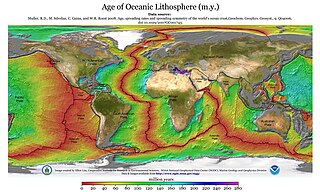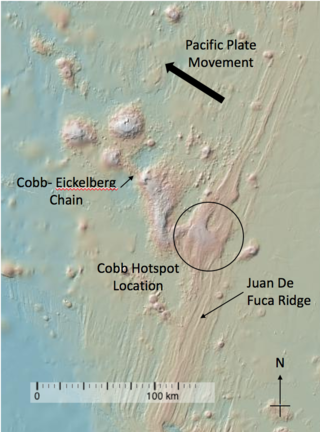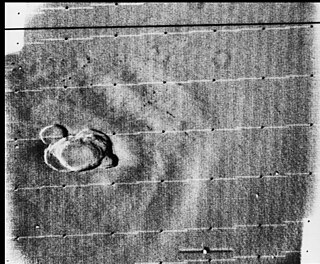Related Research Articles

Basalt is an aphanitic (fine-grained) extrusive igneous rock formed from the rapid cooling of low-viscosity lava rich in magnesium and iron exposed at or very near the surface of a rocky planet or moon. More than 90% of all volcanic rock on Earth is basalt. Rapid-cooling, fine-grained basalt is chemically equivalent to slow-cooling, coarse-grained gabbro. The eruption of basalt lava is observed by geologists at about 20 volcanoes per year. Basalt is also an important rock type on other planetary bodies in the Solar System. For example, the bulk of the plains of Venus, which cover ~80% of the surface, are basaltic; the lunar maria are plains of flood-basaltic lava flows; and basalt is a common rock on the surface of Mars.

An ophiolite is a section of Earth's oceanic crust and the underlying upper mantle that has been uplifted and exposed, and often emplaced onto continental crustal rocks.

In plate tectonics, a divergent boundary or divergent plate boundary is a linear feature that exists between two tectonic plates that are moving away from each other. Divergent boundaries within continents initially produce rifts, which eventually become rift valleys. Most active divergent plate boundaries occur between oceanic plates and exist as mid-oceanic ridges.

Andesite is a volcanic rock of intermediate composition. In a general sense, it is the intermediate type between silica-poor basalt and silica-rich rhyolite. It is fine-grained (aphanitic) to porphyritic in texture, and is composed predominantly of sodium-rich plagioclase plus pyroxene or hornblende.

Island arcs are long chains of active volcanoes with intense seismic activity found along convergent tectonic plate boundaries. Most island arcs originate on oceanic crust and have resulted from the descent of the lithosphere into the mantle along the subduction zone. They are the principal way by which continental growth is achieved.

Oceanic crust is the uppermost layer of the oceanic portion of the tectonic plates. It is composed of the upper oceanic crust, with pillow lavas and a dike complex, and the lower oceanic crust, composed of troctolite, gabbro and ultramafic cumulates. The crust overlies the rigid uppermost layer of the mantle. The crust and the rigid upper mantle layer together constitute oceanic lithosphere.

A flood basalt is the result of a giant volcanic eruption or series of eruptions that covers large stretches of land or the ocean floor with basalt lava. Many flood basalts have been attributed to the onset of a hotspot reaching the surface of the earth via a mantle plume. Flood basalt provinces such as the Deccan Traps of India are often called traps, after the Swedish word trappa, due to the characteristic stairstep geomorphology of many associated landscapes.

A mid-ocean ridge (MOR) is a seafloor mountain system formed by plate tectonics. It typically has a depth of about 2,600 meters (8,500 ft) and rises about 2,000 meters (6,600 ft) above the deepest portion of an ocean basin. This feature is where seafloor spreading takes place along a divergent plate boundary. The rate of seafloor spreading determines the morphology of the crest of the mid-ocean ridge and its width in an ocean basin.

Magmatism is the emplacement of magma within and at the surface of the outer layers of a terrestrial planet, which solidifies as igneous rocks. It does so through magmatic activity or igneous activity, the production, intrusion and extrusion of magma or lava. Volcanism is the surface expression of magmatism.

A back-arc basin is a type of geologic basin, found at some convergent plate boundaries. Presently all back-arc basins are submarine features associated with island arcs and subduction zones, with many found in the western Pacific Ocean. Most of them result from tensional forces, caused by a process known as oceanic trench rollback, where a subduction zone moves towards the subducting plate. Back-arc basins were initially an unexpected phenomenon in plate tectonics, as convergent boundaries were expected to universally be zones of compression. However, in 1970, Dan Karig published a model of back-arc basins consistent with plate tectonics.

The East Australia hotspot is a volcanic province in southeast Australia which includes the Peak Range in central Queensland, the Main Range on the Queensland-New South Wales border, Tweed Volcano in New South Wales, and the Newer Volcanics Province (NVP) in Victoria and South Australia. A number of the volcanoes in the province have erupted since Aboriginal settlement. The most recent eruptions were about 5,600 years ago, and memories of them survive in Aboriginal folklore. These eruptions formed the volcanoes Mount Schank and Mount Gambier in the NVP. There have been no eruptions on the Australian mainland since European settlement.

The Cobb hotspot is a marine volcanic hotspot at, which is 460 km (290 mi) west of Oregon and Washington, North America, in the Pacific Ocean. Over geologic time, the Earth's surface has migrated with respect to the hotspot through plate tectonics, creating the Cobb–Eickelberg Seamount chain. The hotspot is currently collocated with the Juan de Fuca Ridge.

The Azores hotspot is a volcanic hotspot in the Northern Atlantic Ocean. The Azores is relatively young and is associated with a bathymetric swell, a gravity anomaly and ocean island basalt geochemistry. The Azores hotspot lies just east of the Mid-Atlantic Ridge

Volcanic activity, or volcanism, has played a significant role in the geologic evolution of Mars. Scientists have known since the Mariner 9 mission in 1972 that volcanic features cover large portions of the Martian surface. These features include extensive lava flows, vast lava plains, and the largest known volcanoes in the Solar System. Martian volcanic features range in age from Noachian to late Amazonian, indicating that the planet has been volcanically active throughout its history, and some speculate it probably still is so today. Both Earth and Mars are large, differentiated planets built from similar chondritic materials. Many of the same magmatic processes that occur on Earth also occurred on Mars, and both planets are similar enough compositionally that the same names can be applied to their igneous rocks and minerals.

Ocean island basalt (OIB) is a volcanic rock, usually basaltic in composition, erupted in oceans away from tectonic plate boundaries. Although ocean island basaltic magma is mainly erupted as basalt lava, the basaltic magma is sometimes modified by igneous differentiation to produce a range of other volcanic rock types, for example, rhyolite in Iceland, and phonolite and trachyte at the intraplate volcano Fernando de Noronha. Unlike mid-ocean ridge basalts (MORBs), which erupt at spreading centers (divergent plate boundaries), and volcanic arc lavas, which erupt at subduction zones (convergent plate boundaries), ocean island basalts are the result of intraplate volcanism. However, some ocean island basalt locations coincide with plate boundaries like Iceland, which sits on top of a mid-ocean ridge, and Samoa, which is located near a subduction zone.

Terry Ann Plank is an American geochemist, volcanologist and professor of earth science at Columbia College, Columbia University, and the Lamont Doherty Earth Observatory. She is a 2012 MacArthur Fellow and member of the National Academy of Sciences. Her most prominent work involves the crystal chemistry of lava minerals in order to determine magma ages and movement, giving clues to how quickly magma can surface as lava in volcanoes. Most notably, Plank is known for her work establishing a stronger link between the subduction of ocean sediments and volcanism at ocean arcs. Her current work can be seen at her website.
Plank states that her interest in volcanoes began when her Dartmouth professor took her and other students to Arenal volcano in Costa Rica. He had them sit and have lunch while on top of a slow-moving lava flow and while watching bright red goops of lava crack out from their black casings. "It was totally cool, how could you not like that?" Plank recalled the event to State of the Planet, an Earth Institute News source at Columbia University.
The Troodos Ophiolite on the island of Cyprus represents a Late Cretaceous spreading axis that has since been uplifted due to its positioning on the overriding Anatolian plate at the Cyprus arc and ongoing subduction to the south of the Eratosthenes Seamount.
Stanley Robert Hart is an American geologist, geochemist, leading international expert on mantle isotope geochemistry, and pioneer of chemical geodynamics.

The plate theory is a model of volcanism that attributes all volcanic activity on Earth, even that which appears superficially to be anomalous, to the operation of plate tectonics. According to the plate theory, the principal cause of volcanism is extension of the lithosphere. Extension of the lithosphere is a function of the lithospheric stress field. The global distribution of volcanic activity at a given time reflects the contemporaneous lithospheric stress field, and changes in the spatial and temporal distribution of volcanoes reflect changes in the stress field. The main factors governing the evolution of the stress field are:
- Changes in the configuration of plate boundaries.
- Vertical motions.
- Thermal contraction.
Intraplate volcanism is volcanism that takes place away from the margins of tectonic plates. Most volcanic activity takes place on plate margins, and there is broad consensus among geologists that this activity is explained well by the theory of plate tectonics. However, the origins of volcanic activity within plates remains controversial.
References
- 1 2 3 Ellins, Katherine (2002). "Women Exploring the Oceans". Eos Transactions. 83 (10): 109. Bibcode:2002EOSTr..83..109E. doi: 10.1029/2002EO000067 . Retrieved 2019-05-26.
- 1 2 "Emily M. Klein". women oceanographers. Retrieved 16 April 2021.
- 1 2 3 4 5 "Emily Klein Brings Light to the Dark Reaches of the Volcanic Ocean Seabed – Duke Environment Magazine" . Retrieved 2019-05-26.
- 1 2 3 "Bruce C. Heezen Memorial Prize - Established 1979 | Earth and Environmental Sciences". eesc.columbia.edu. Retrieved 2019-05-26.
- 1 2 3 "Langmuir Receives 1996 Bowen Award". Honors Program. Retrieved 2019-05-26.
- ↑ Klein, Emily M.; Langmuir, Charles H. (1987). "Global correlations of ocean ridge basalt chemistry with axial depth and crustal thickness". Journal of Geophysical Research. 92 (B8): 8089. Bibcode:1987JGR....92.8089K. doi:10.1029/jb092ib08p08089. hdl: 10161/8314 . ISSN 0148-0227.
- ↑ Langmuir, Charles H.; Klein, Emily M.; Plank, Terry (2013), "Petrological Systematics of Mid-Ocean Ridge Basalts: Constraints on Melt Generation Beneath Ocean Ridges", Mantle Flow and Melt Generation at Mid-Ocean Ridges, American Geophysical Union (AGU), pp. 183–280, doi:10.1029/gm071p0183, hdl: 10161/8316 , ISBN 9781118663875
- 1 2 "Emily Klein Brings Light Dark Reaches Volcanic Ocean Seabed". Nicholas Duke. Retrieved 16 April 2021.
- ↑ "Earth & Ocean Sciences (EOS) Division | Nicholas School of the Environment". nicholas.duke.edu. Retrieved 2019-05-26.
- 1 2 Ellins, Katherine (2002). "Women Exploring the Oceans". Eos Transactions. 83 (10): 109. Bibcode:2002EOSTr..83..109E. doi: 10.1029/2002EO000067 . Retrieved 2019-05-26.
- ↑ Holland, Heinrich D.; Rudnick, R. L.; Turekian, Karl K. (2005). The Crust. Elsevier. ISBN 9780080448473.
- 1 2 Doherty, Lamont (2013-04-24), Volcanoes and Vents: A Hidden World Beneath the Sea , retrieved 2019-05-26
- 1 2 "New Deep-Sea Hydrothermal Vents, Life Form Discovered". www.nsf.gov. Retrieved 2019-05-26.
- ↑ "Expedition to the Cocos-Nazca Spreading Center". Expedition to the Cocos-Nazca Spreading Center. Retrieved 2019-05-26.
- 1 2 "Women Exploring the Ocean". women oceanographers. Retrieved 16 April 2021.
- ↑ "Exploring the Ocean's Geology". living on earth. Retrieved 16 April 2021.
- ↑ "F.W. Clarke Award | Geochemical Society". www.geochemsoc.org. Retrieved 2019-05-26.
- ↑ "F. Earl Ingerson Lecture | Geochemical Society". www.geochemsoc.org. Retrieved 2019-05-26.
- ↑ "Klein Recognized with Endowment in Her Honor | Nicholas School of the Environment". nicholas.duke.edu. Retrieved 2019-05-26.
- ↑ "Emily Klein to Serve as Chair of Earth and Ocean Sciences | Nicholas School of the Environment". nicholas.duke.edu. Retrieved 2019-05-26.
- ↑ "Emily Klein Honored with University Distinguished Service Professorship". Nicholas School of the Environment. Retrieved 2020-11-21.
- ↑ "Five Duke Faculty Named AAAS Fellows for 2021". today.duke.edu. Retrieved 2022-07-14.
- ↑ "Emily Klein". Research Gate. Retrieved 16 April 2021.